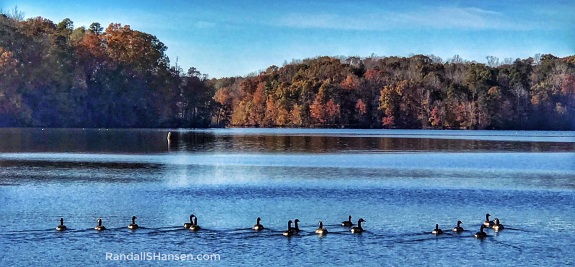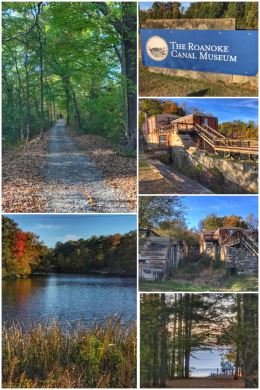
After rushing through Maryland and Virginia, it was nice to know we would be spending about two weeks traveling through North Carolina — the 41st state we have visited on this trip!
North Carolina, the Tar Heel State, was another of the original 13 colonies — and was the FIRST state to instruct its delegates to vote for independence from the British crown during the Continental Congress. It became a state on November 21, 1789. The state was a major producer of cotton and tobacco. The state licence plate read “First in Flight” because of Orville and Wilbur Wright’s first powered airplane flight on December 17, 1903, which 120 feet and lasted 12 seconds. The state welcome sign says “nation’s most military friendly state,” which is reinforced by the eight military bases located here. (Only the navy does not have a base in the state.) The state tree is the pine — which may play a role in the state’s nickname, with the tar coming from the pine pitch.
We started our exploration in Roanoke Rapids, a small (16,000 population) city in northeast North Carolina on the eastern edge of the North Carolina Piedmont, along the Roanoke River — not far from I-95. It was established as a textile mill town; today, sadly, all those mills are closed and the city still has a fairly high unemployment rate as it tries to reinvent itself.
We were amazed — again — to find canal history here. The Roanoke Canal Museum and Trail is one of the city’s oldest historical sites — with the old lock control building now serving as a museum. In 1976, the canal, the tow path, and the canal structures were added to the National Register of Historic Places. The 15-mile trail, which follows the towpath for the 39-foot wide canal designed for use by batteaux boats, has all sorts of interesting history. The canal (and locks) were needed to deal with the “great falls” in the Roanoke River near Weldon… and the canal itself is just one tiny part of what was planned as the Roanoke Navigation System, which was designed to connect the Blue Ridge Mountains of Virginia all the way to Norfolk… across a distance of 400 miles.
Because we love hiking a good trail and because of our fascination with all these transportation canals that were built in the 1800s to foster trade — in this case, using the Roanoke River between Roanoke Rapids and Weldon — we decided to hike from the museum to the Roanoke Rapids Dam. (There is also parking/access points at the dam, River Road, the Aqueduct, and River Falls Park.) We were stunned to see the remnants of a massive bulkhead on the other side of the navigational canal — only to learn that it is one of the remnants of a dam on a much deeper, wider, and shorter “power canal” built by the Roanoke Rapids Power Company in the 1890s.
Interesting fact: Weldon is the only surviving town created primarily by the canal’s construction — and happily, the impressive stone aqueduct in Weldon that carried the canal over Chockoyotte Creek has been preserved as part of the Canal Trail.

We then traveled to Greensboro, where our main mission was visiting with some more of Ran’s cousins, but before we did that… we jumped at the chance to hike on the Nat Greene Trail, which follows along Lake Brandt (shown in the photo at the top of the blog). Lake Brandt is actually an 816-acre municipal reservoir originally built in 1925.
The 3.6-mile trail winds through diverse mixed hardwoods and pines along the watershed buffer on the lake’s southeast edge — and is one of six watershed trails designated as part of the North Carolina Mountains-to-Sea Trail system. Main trail parking is available at the north end of the trail at the Lake Brandt Marina — next to the large trailhead sign. When the marina is closed, parking is available on the right side of the gate with the trail access on the left, which is where we parked the day we hiked. (There is also a very small parking area at the very south end of the trail at the Old Battleground trailhead.) During the spring and summer, the marina also rents stand-up-paddle boards, rowboats, canoes, and kayaks.
Greensboro is North Carolina’s third largest city, which surprised Ran as he remembered it as a much smaller, quieter town when he visited his uncle’s family here in this youth. We decided Greensboro’s nickname should be the Highway City, as multiple roadways intersect in and around the city — and three major interstate highways (I-40, I-85, and I-73) converge around the city.
Given the city’s size, we were quite happy to find the Jazzercise Greensboro Fitness Center, located on Spring Garden Street. We were so happy, in fact, that we went to two different classes there while we were in Greensboro. When we have a full day of working, a Jazzercise class is one of the best options for a fast, fun, and powerful workout!
Greensboro was also great for retail! In fact, we made an interesting discovery, albeit a bit late on this trip — but some Costco Wholesale stores refill propane tanks. We stopped at Warehouse #339 and bought the cheapest propane on this trip ($1.72 a gallon), refilling one of our twin canisters from our trailer. We also bought gas and numerous organic food stuff. Speaking of organic, we also really loved Deep Roots Market, a wonderful natural foods market on North Eugene Street in Greensboro. Finally, as an early birthday treat for Jen, Ran scheduled her for a deep tissue massage at Balance Day Spa, located on Battleground Avenue. (She loved the pampering she received there.)
The next day, we met up with cousin Julie and her family — for a fun evening of dinner (at Lucky 32 Southern Kitchen) and bowling (at Spare Time Family Fun Center). It was great reconnecting with Julie and her husband Tim… and wonderful to see two of their children.
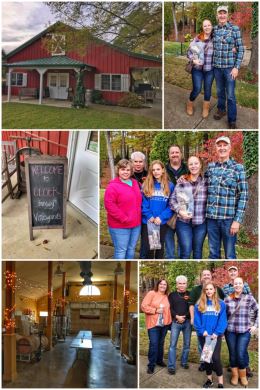
We ended the visit by all going together to met up cousin Bob and his family at Cloer Family Vineyards, located near Apex, about 15 miles west of Raleigh.
The unique history of this winery is that — like many others around the country — they originally planted their vineyard with various popular hybrid and French varietals… only to discover they had to constantly spray the grapes with harsh chemicals to deal with mold, mildew, and insects. After 12 years, they pulled up ALL of their grapes and replanted with ONLY Muscadine plants – native vines that were actually discovered by Sir Walter Raleigh’s explorers in North Carolina’s Outer Banks in the 1500’s. The winery is only one of two family-owned farms in the Raleigh-Durham area that grow their own grapes and produce their own wines on site… though to increase their wine selections, they do purchase grapes from other North Carolina vineyards.
It was fun tasting with a group, as Jen, Ran, and Bob preferred the Matador, a dry, but fruity medium-bodied Merlot. Julie and Wendy preferred the sweeter wines, with Julie loving the Riesling. We bought two bottles — the Matador, but also the Noble — which is a unique semi-sweet red Muscadine with a wonderful flavor. Tastings are $5 per person for five tastings.
We sadly said goodbye to Greensboro after meeting up with Julie’s oldest daughter and her husband… well, not the city as the traffic was crazy… but to Ran’s relatives. Our next stop was Fayetteville, which puzzled a lady from the Greensboro Jazzercise when she asked where we were going to next. “Fayetteville? Why would you go there??” She made it seem as though the city was filled with crime and no one went there unless they had to. We were mainly going to Fayetteville to see a former student of Ran’s, but also because it was part of our plan to see more of the state.
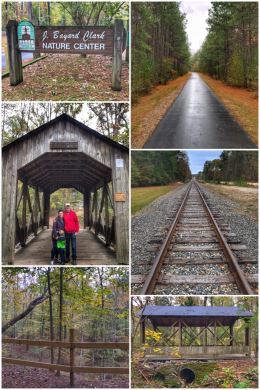
Fayetteville is the state’s 6th largest city — and interestingly, has received the All-American City Award from the National Civic League three times. It’s perhaps best known for being the home of Fort Bragg — one of the largest U.S. Army bases — home to 60,000 soldiers.
We met up with Chantele and her son at Clark Park, located on Sherman Drive — Fayetteville’s second largest regional park, and which is dedicated to preserving the environment, educating the public about nature, and providing the only camping in the area. Its nature center features fun and educational displays — as well as several live animals (including turtles, snakes, hissing cockroaches, green anoles (lizards), and even an alligator.
After catching up with Chantele and making plans to see each other again in northeast Washington next summer, we hit the trails. The park itself has several trails that can all be accessed from the nature center — though construction had a few of them partially closed. We hiked part of the Bear Trail (a .6-mile loop), Laurel Trail (.4-mile loop), and Wetland Trail. We also hiked a bit of the Cape Fear River Trail, a paved 5-mile long rail-trail that runs right through the park, and winds its way through a mix of woodlands and marshes, offering great views of the Cape Fear River. We would have walked/hiked more, but heavy rains had us rushing back to the truck… and then home to the trailer.
We then headed eastward to spend several days along the North Carolina coast, starting in New Bern — located at the confluence of the Neuse and Trent Rivers. The city is named after Bern, Switzerland. (And even though we spent several days in these coastal towns, we never did quite make it to the coast!)

We did not know it at the time, but soon discovered that New Bern — like many other coastal towns in the Carolinas — is susceptible to flooding and damage from hurricanes. In fact, we later learned, parts of the area are STILL recovering from Hurricane Florence, which made landfall more than a year ago in September 2018 — just south of Wrightsville Beach, about 90 miles southeast of New Bern. That hurricane created a storm surge of 6 feet, as well as days of heavy rains — all of which severely flooded various parts of the town and surrounding areas… including some of the trails in the Croatan National Forest that we had hoped to hike.
We started on the Neusiok Trail, a 20-mile hiking trail located in the Croatan National Forest, and which is a beautiful trail that follows along both the Neuse River and the Newport River… passing through cypress swamps, hardwood ridges, longleaf pine savannah, and shrubby bogs. We should have known something was wrong, however, when we tried to start the trail from its northern terminus at Pine Cliffs Recreation Area and found the road closed. We used the AllTrails app to follow the trail and found a small parking area off of Ferry Road. We hiked the trail as far as we could go before swamp and bushwhacking was a bit too much. Bizarrely, in the time it took us to turn around and get back to the truck, forest managers had come by and closed the trail with signage and tape — as can be seen in the photos… closed for the foreseeable future because of too much damage from last year’s hurricane. Kind of mind-boggling and perhaps another sign we are not spending enough to protect and preserve our national forests.
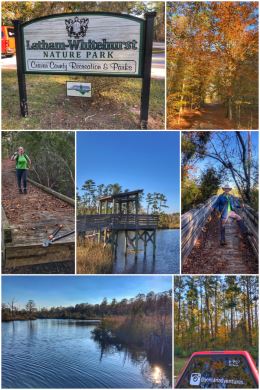
Not to be deterred from getting in some quality time in nature, we decided to travel up to Latham-Whitehurst Nature Park — a county park located in New Bern.
The park features a series of interconnecting trails as well as a 2,000-foot boardwalk which overlooks the very pretty and naturally wild Broad Creek. There’s also a dock on-site that includes a fishing area as well as a canoe and kayak launch. The park was only opened in 2011, but it too was affected by Hurricane Florence — with a bridge on one of the trails lifted off its footings and now slanted at an angle. We hiked two large loops around the edges of the park for a total of about 3.5 miles.
The trails were a bit overgrown, so one the second loop we left our hiking poles behind and grabbed our clipping tools… and did some serious trail cleanup of low-hanging limbs and brush invading the trail.

Perhaps the most exciting discovery in New Bern, however, was shopping at a Publix — officially known as Publix Super Markets, Inc., an employee-owned, supermarket chain headquartered in Lakeland, Florida… and well-known for its amazing customer service. We are looking forward to shopping at many Publix locations as we travel the southeast.
As we often do, we wandered in to do a little food shopping, hoping to find some organic vegetables and Zevia soda. What we found — in addition to those items — was our latest obsession… Rebel Ice Cream, a keto-friendly ice cream that has some interesting and yummy flavors — all with NO sugar; instead, sweetened with erythritol (a sugar alcohol) and monk fruit (a natural, high intensity sweetener). Rebel describes their ice cream this way: “We use all-natural, keto-friendly ingredients that won’t raise your blood sugar, raise your insulin levels, or kick you out of a fat-burning state. Rebel Ice Cream also has the perfect amount of fat to maintain that superior taste and texture of real ice cream. It is also the lowest ‘net carb’ ice cream on the market. Our ice cream is 100% grain and gluten-free with no added sugar.”
Our final destination in North Carolina was Wilmington, though our plans for our time in Wilmington changed when the Check Engine light illuminated on the drive there to let us know of a problem with the emissions system. While Ran drove, Jenny made some phone calls and we were able to get the truck serviced the next day — and get a new valve for the faulty one causing the problems.
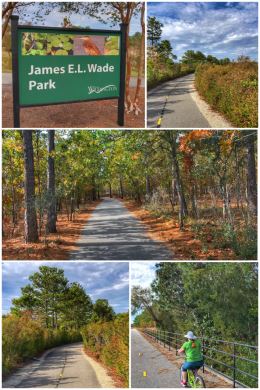
Wilmington was also the location in which we switched out our faulty bumper hitch with a much improved version… and since we had to take our bikes off the trailer to get to the hitch, we decided to take advantage of the beautiful weather to go on another bike ride.
While we could not find any rail-trails in the vicinity, we did find a fairly lovely greenway in the Gary Shell Cross-City Trail, a 15-mile trail that connects to the East Coast Greenway and River-to-Sea Bikeway, traveling through several city parks and along designated bike paths. For a city greenway, it is a pleasant ride — with just enough nature, as you can see in the photos in the collage. When not along roadways, the path travels through four city parks: Halyburton Park, Empie Park, McCrary Park, and Wade Park. We started (and ended) the bike ride at James E. L. Wade Park, a 17-acre park that also happens to be one of the newest public parks in the Wilmington area. The park includes a paved, .5-mile long walking trail loop — complete with multiple bridges over a local creek. It also includes an open play area with adjacent benches for parents, a playground, shaded picnic area, and restrooms.
We ended our time in Wilmington on a roll — taking in a class at the Port City Jazzercise (located on Oleander Drive), as well as doing a little organic shopping at Tidal Creek Co-op (also located on Oleander Drive), Earth Fare (on Military Cutoff Road), and Publix (located on Market Street). We also stopped in another Costco Wholesale (#635) to purchase some food items, as well as gas up the truck for our next adventure… into our next state — South Carolina — and our next national park!
